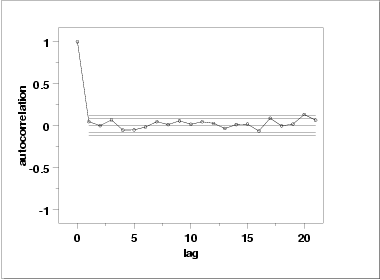1.4. EDA Case Studies
1.4.2. Case Studies
1.4.2.1. Normal Random Numbers
1.4.2.1.3. |
Quantitative Output and Interpretation |
Sample size = 500
Mean = -0.2935997E-02
Median = -0.9300000E-01
Minimum = -0.2647000E+01
Maximum = 0.3436000E+01
Range = 0.6083000E+01
Stan. Dev. = 0.1021041E+01
Coefficient Estimate Stan. Error t-Value
B0 0.699127E-02 0.9155E-01 0.0764
B1 -0.396298E-04 0.3167E-03 -0.1251
Residual Standard Deviation = 1.02205
Residual Degrees of Freedom = 498
The absolute value of the t-value
for the slope parameter is smaller than the critical value of
t0.975,498 = 1.96. Thus, we conclude that the slope is not
different from zero at the 0.05 significance level.
H0: σ12 = σ22 = σ32 = σ42
Ha: At least one σi2 is not equal to the others.
Test statistic: T = 2.373660
Degrees of freedom: k - 1 = 3
Significance level: α = 0.05
Critical value: Χ21-α,k-1 = 7.814728
Critical region: Reject H0 if T > 7.814728
In this case, Bartlett's test indicates that the variances are
not significantly different in the four intervals.
Another check is an autocorrelation plot that shows the autocorrelations for various lags. Confidence bands can be plotted at the 95 % and 99 % confidence levels. Points outside this band indicate statistically significant values (lag 0 is always 1).

The lag 1 autocorrelation, which is generally the one of most interest, is 0.045. The critical values at the 5% significance level are -0.087 and 0.087. Since 0.045 is within the critical region, the lag 1 autocorrelation is not statistically significant, so there is no evidence of non-randomness.
A common test for randomness is the runs test.
H0: the sequence was produced in a random manner
Ha: the sequence was not produced in a random manner
Test statistic: Z = -1.0744
Significance level: α = 0.05
Critical value: Z1-α/2 = 1.96
Critical region: Reject H0 if |Z| > 1.96
The runs test fails to reject the null hypothesis that the data were
produced in a random manner.
A quantitative enhancement to the probability plot is the correlation coefficient of the points on the probability plot, or PPCC. For this data set the PPCC based on a normal distribution is 0.996. Since the PPCC is greater than the critical value of 0.987 (this is a tabulated value), the normality assumption is not rejected.
Chi-square and Kolmogorov-Smirnov goodness-of-fit tests are alternative methods for assessing distributional adequacy. The Wilk-Shapiro and Anderson-Darling tests can be used to test for normality. The results of the Anderson-Darling test follow.
H0: the data are normally distributed
Ha: the data are not normally distributed
Adjusted test statistic: A2 = 1.0612
Significance level: α = 0.05
Critical value: 0.787
Critical region: Reject H0 if A2 > 0.787
The Anderson-Darling test rejects the normality assumption at the
0.05 significance level.
H0: there are no outliers in the data
Ha: the maximum value is an outlier
Test statistic: G = 3.368068
Significance level: α = 0.05
Critical value for an upper one-tailed test: 3.863087
Critical region: Reject H0 if G > 3.863087
For this data set, Grubbs' test does not detect any outliers at
the 0.05 significance level.
-
Yi = C + Ei
Analysis of 500 normal random numbers
1: Sample Size = 500
2: Location
Mean = -0.00294
Standard Deviation of Mean = 0.045663
95% Confidence Interval for Mean = (-0.09266,0.086779)
Drift with respect to location? = NO
3: Variation
Standard Deviation = 1.021042
95% Confidence Interval for SD = (0.961437,1.088585)
Drift with respect to variation?
(based on Bartletts test on quarters
of the data) = NO
4: Data are Normal?
(as tested by Normal PPCC) = YES
(as tested by Anderson-Darling) = NO
5: Randomness
Autocorrelation = 0.045059
Data are Random?
(as measured by autocorrelation) = YES
6: Statistical Control
(i.e., no drift in location or scale,
data are random, distribution is
fixed, here we are testing only for
fixed normal)
Data Set is in Statistical Control? = YES
7: Outliers?
(as determined by Grubbs' test) = NO

